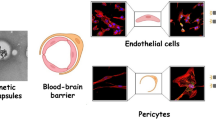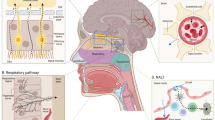Abstract
The aim of our present work was to develop indinavir O/W submicron lipid emulsions (SLEs) loaded with lipoamino acids for specific delivery to brain. Tetradecyl aspartic acid (A) and decyl glutamic acid (G) loaded stable SLEs of indinavir having a mean size range of 210–220 nm and average zeta potential of −23.54 ± 1.2 mV were developed using homogenization and ultrasonication. The cumulative % drug release from different SLEs varied in between 26% and 85%. The formulations, SLE, SLE-A3, and SLE-G3 were stable to the centrifugal stress, dilution stress, and storage at RT. The total drug content and entrapment efficiency were determined by HPLC method. During pharmacokinetic studies in male Wistar rats there was no significant difference in the serum levels of indinavir for SLE, SLE-A3 and SLE-G3 formulations at all time points. In tissue distribution studies, the therapeutic availability (TA) of indinavir in brain and kidneys for SLE-A3 were 4.27- and 2.66-fold whereas for SLE-G3 were 2.94 and 2.12 times, respectively, higher than that of indinavir solution. But when compared with that of SLE, in brain tissue the levels of indinavir from SLE-G3 and SLE-A3 varied in between 2.5- and 3.38-fold. While in case of the kidney, it was between 1.23- and 1.54-fold only. However, the TA is not significantly different in tissues like the heart, liver, and spleen. Thus, brain-specific delivery of indinavir was improved by including tetradecyl aspartic acid and decyl glutamic acid in submicron lipid emulsions.








Similar content being viewed by others
References
Gulick RM, Mellors JW, Havlir D, Eron JJ, Gonzalez C, McMahon D, et al. Treatment with indinavir, zidovudine and lamivudine in adults with human immunodeficiency virus infection and prior antiretroviral therapy. New Eng J Medicine. 1997;337:734–9.
Acosta EP, Henry K, Baken L, Page LM, Fletcher CV. Indinavir concentrations and antiviral effect. Pharmacotherapy. 1999;19:708–12.
Pialoux G, Fournier S, Moulignier A, Poveda JD, Clavel F, Dupont B. Central nervous system as a sanctuary for HIV-1 infection despite treatment with zidovudine, lamivudine and indinavir. AIDS. 1997;11:1302–3.
Hamidi M. Role of P-glycoprotein in tissue uptake of indinavir in rat. Life Sci. 2006;79:991–8.
Christensen HN. Role of amino acid transport and counter transport in nutrition and metabolism. Physiol Rev. 1990;70:43–77.
Pardridge WM. Brain metabolism: a perspective from the blood–brain barrier. Physiol Rev. 1983;63:1481–535.
Hiroshi U, Kanai Y, Kim DK, Wempe MF, Chairroungdua A, Morimoto E, et al. Transport of amino acid-related compounds mediated by L-type amino acid transporter (LAT1): insights into the mechanisms of substrate recognition. Mol Pharmacol. 2002;61:729–37.
Toth I. A novel chemical approach to drug delivery: lipidic amino acid conjugates. J Drug Target. 1994;2:217–39.
Pignatello R, Jansen G, Kathmann I, Puglisi G, Toth I. Lipoamino acid conjugates of methotrexate with antitumor activity. J Pharm Sci. 1998;87:367–71.
Wong A, Toth I. Lipid, sugar and liposaccharide based delivery systems. Curr Med Chem. 2001;8:1123–36.
Zhong W, Skwarczynski M, Toth I. Lipid core peptide system for gene, drug, and vaccine delivery. Aust J Chem. 2009;62:956–67.
Bumol TF. 4th Inter. Conf. Monoclonal antibody immunoconjugates for cancer, 30Mar–1 April, San Diego; 1989. p. 50
Youssef M, Fattal E, Alonso MJ, Robot TL. Effectiveness of nanoparticle bound ampicillin in the treatment of Listeria monocytogenes infection in athymic nude mice. Antimicrob Agents Chemother. 1988;31:104.
Lundberg BB. Preparation of drug-carrier emulsions stabilized with phosphatidyl choline-surfactant mixtures. J Pharm Sci. 1994;83:72–5.
Muralidhar Rao A. Development of colloidal drug delivery systems containing lipoamino Acids. Ph.D. thesis, Kakatiya University; 2008.
Lee GWJ, Groves MJ. A pragmatic approach to the particle sizing of submicrometer emulsions using a laser nephelometer. Powder Technol. 1981;28:49–54.
Krishna G, Wood GC, Sheth BB. Improving emulsification efficacy of lecithin by formulation design. I. Effect of adding secondary surfactant. PDA J Pharm Sci Technol. 1998;52:331–6.
Hamidi M. Simple and sensitive high-performance liquid chromatography method for the quantitation of indinavir in rat plasma and central nervous system. J Sep Sci. 2006;29:620–7.
Patlolla RR, Vobalaboina V. Pharmacokinetics and tissue distribution of etoposide delivered in parenteral emulsion. J Pharm Sci. 2005;94(2):437–45.
Varshika E, Prabhakar K, Kishan V. Preparation, characterization and in vivo pharmacodynamic evaluation of parenteral diclofenac submicron lipid emulsions. PDA J Pharm Sci Technol. 2009;63(2):1368–72.
Yosuke O, Shoji T, Shinji T. Evaluation of pH-responsive liposomes containing amino acids-based zwitterionic lipids for improving the intracellular drug delivery in vitro and in vivo. J Control Release. 2009;142(2):267–76.
Takamura A, Ishii F, Noro S, Tanifuji M, Nakajima S. Study of intravenous hyperalimentation: effect of selected amino acids on the stability of intravenous fat emulsions. J Pharm Sci. 1984;73:91–4.
Groves MJ, Herman CJ. The redistribution of bulk aqueous phase phospholipids during thermal stressing of phospholipid-stabilized emulsions. J Pharm Pharmacol. 1993;45:592–6.
Chansiri G, Lyons RT, Patel MV, Hem SL. Effect of surface charge on the stability of O/W emulsions during steam sterilization. J Pharm Sci. 1999;88:454–8.
Shotton E, Davis SS. A note on the stability of emulsion on high dilution. J Pharm Pharmacol. 1968;20(11):825–9.
Hunt CA, Mac Gregor RD, Siegel RA. Engineering targeted in vivo drug delivery. I. The physiological and physiochemical principles governing opportunities and limitations. Pharm Res. 1986;3:333–44.
Brewster ME, Anderson W, Bodor N. Brain, blood and cerebrospinal fluid distribution of a Zidovudine chemical delivery system in rabbits. J Pharm Sci. 1991;80:843–6.
Acknowledgments
We are thankful to Dr. A. Muralidhar Rao and M/s Lipoid, Germany for providing us the gift samples of lipoamino acids and lecithin respectively for the study and Prof. Y. Madhusudan Rao for his kind help for HPLC facility. Mrs. B. Swetha thanks AICTE for the fellowship during her studies. We acknowledge the AICTE, New Delhi for RPS project grant F. No 8023/BOR/RID/RPS-155/2008-09 for doing this work.
Author information
Authors and Affiliations
Corresponding author
Rights and permissions
About this article
Cite this article
Bollam, S., Kandadi, P., Apte, S.S. et al. Development of Indinavir Submicron Lipid Emulsions Loaded with Lipoamino Acids—In Vivo Pharmacokinetics and Brain-Specific Delivery. AAPS PharmSciTech 12, 422–430 (2011). https://doi.org/10.1208/s12249-011-9604-3
Received:
Accepted:
Published:
Issue Date:
DOI: https://doi.org/10.1208/s12249-011-9604-3




